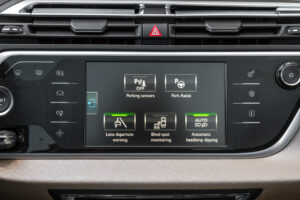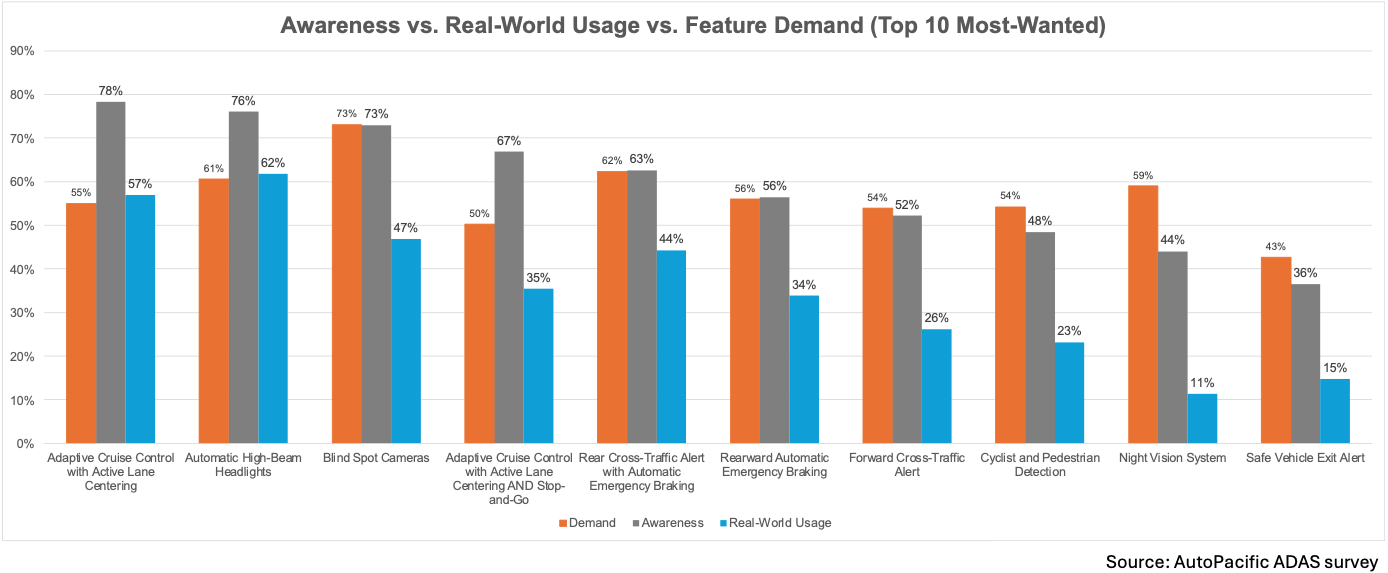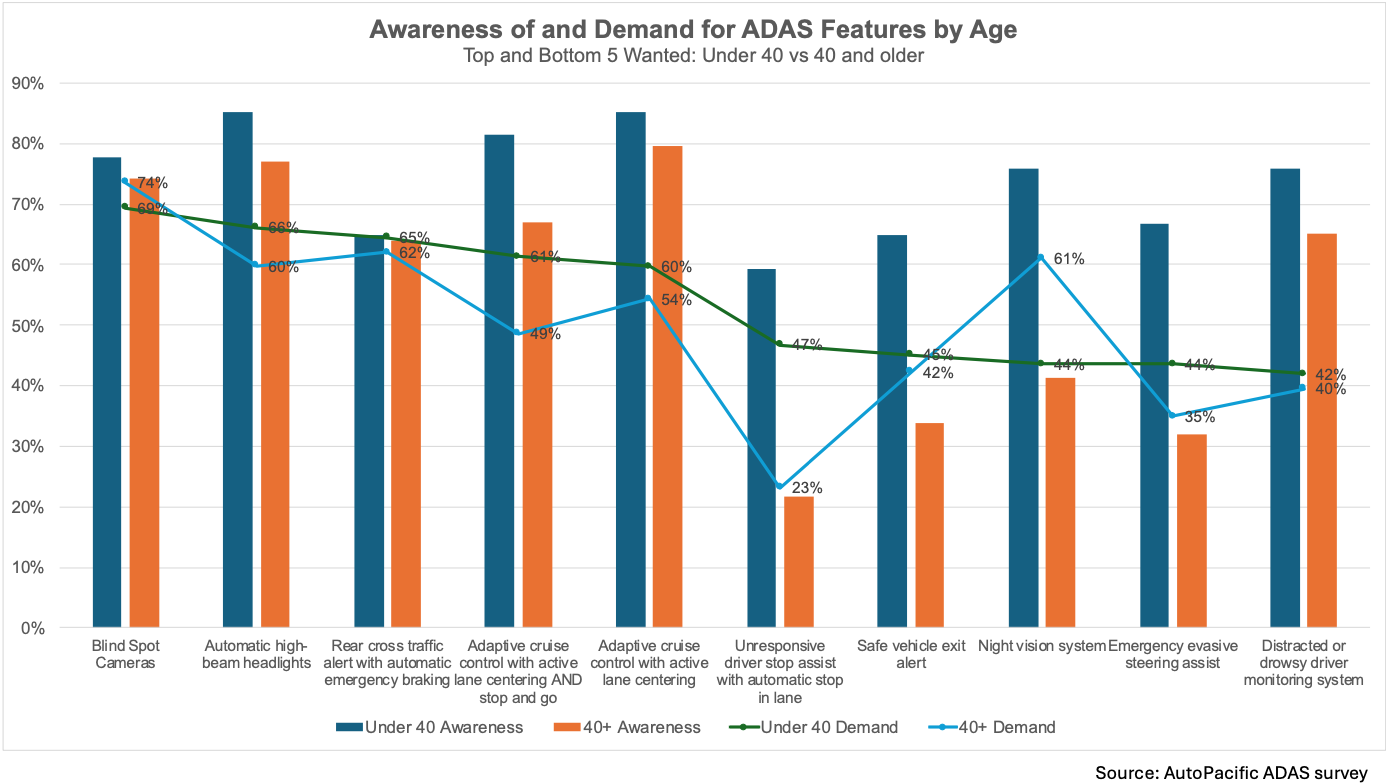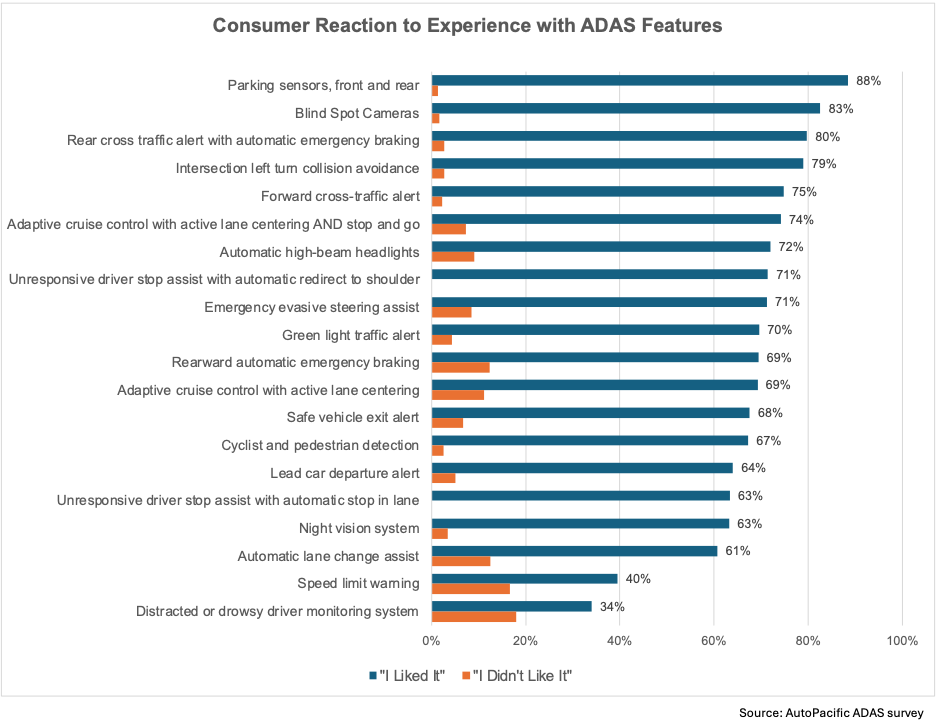
ADAS survey finds awareness, experience linked and affect demand
By onMarket Trends | Technology
New research has found that, over the last few years, many ADAS features have become less in demand by drivers, partially attributable to a lack of real-world situations to experience features firsthand, even if their vehicles are equipped with them.
Automotive research firm AutoPacific surveyed more than 500 current vehicle owners in February about their familiarity and experience with 19 ADAS features and interest in having them in their next new vehicle.
In a report on the survey results, AutoPacific wrote that some ADAS features, like Automatic High-Beam Headlights and Adaptive Cruise Control with Active Lane Centering, engage often during consumers’ drives. Therefore, 62% and 57%, respectively, of respondents said they’ve heard of and experienced the features.
“Conversely, ADAS features that typically only intervene in the event of a required emergency maneuver, like Cyclist and Pedestrian Detection or Safe Vehicle Exit Assist have a much lower percentage of use, 23% and 11%, respectively,” AutoPacific wrote. “As such, in many cases, demand for the feature correlates closely with awareness.”
“Credit clever advertising both on social media, television, and word of mouth, as many consumers know about these safeguarding features, even if they have yet to use the feature in the event of an emergency,” said Robby DeGraff, AutoPacific manager of product and consumer insights, in the report. “Some of them are true lifesavers, and once one of these ADAS features activates, that’s bound to boost trust in the technology itself and quickly turn into a ‘must-have’ for the driver.”
Vehicle owners surveyed were most aware of ADAS features that vehicles have been equipped with for many years, like Blind Spot Cameras (73%) and Rear Cross-Traffic Alert With Automatic Emergency Braking (63%).
Awareness drops sharply for newer, more advanced ADAS features, like Unresponsive Driver Stop Assist (25%) or Emergency Evasive Steering Assist (34%), according to AutoPacific.
Awareness also drops with age. Those under 40 were more aware of all features surveyed, including the newest and least-known features, than those 40 and older.
Eighty-nine percent of respondents ages 18-39 said they’ve heard of Automatic Lane Change Assist compared to 47% of those 60 and older.
However, AutoPacific found that awareness doesn’t equal demand.
“Historically, when looking at AutoPacific’s [Future Attribute Demand Study] FADS data, demand for features that enhance visibility has been higher from older consumers than younger consumers,” wrote Deborah Grieb, AutoPacific director of marketing and consumer insights. “The same holds true here where demand is higher from respondents ages 40 and older for Night Vision, Blind Spot Cameras, and Rearward Automatic Emergency Braking – all features that assist the driver with their ability to easily see around them.”
Both Speed Limit Warning and Distracted or Drowsy Driver Monitoring were ranked high in awareness and use but dissatisfaction was also high, according to AutoPacific.
“These two features also have the highest percent of dissatisfaction from users, with 18% of those who have experienced Distracted or Drowsy Driver Monitoring and 17% of those who have experienced Speed Limit Warning saying they didn’t like the feature,” the report states. “It’s important to note that for the two aforementioned ADAS features, as well several ADAS features that ranked much higher in terms of demand, consumers have to be able to adjust or change the sensitivity of the feature and have the option to turn it on or off. Forty-four percent of those who have used Speed Limit Warning felt neutral about it, and 17% didn’t like it, mostly due to annoying nagging reminders and beeping alerts. In addition to complaints about it not working properly, nearly half of those who didn’t like Distracted or Drowsy Driver Monitoring complain of not being able to adjust or change the sensitivity.”
A separate recent survey, conducted by Nationwide Insurance, found that most drivers recognize the importance of safe driving but there is a “troubling gap between awareness and action.”
The online survey was conducted in March, to which 1,000 general consumers and 400 commercial drivers responded.
“Many admit to risky behaviors behind the wheel — often involving smartphones and other distractions,” Nationwide said in a press release. “An overwhelming majority say unsafe driving habits have increased over the past year, with 92% agreeing that drivers are looking at their phones more frequently. Even more alarming, 1 in 10 (11%) confess to reading or writing emails while driving.”
Phones also continue to distract drivers, according to the survey results.
Most survey respondents said they’re aware of distracted driving laws:
-
- Texting restrictions — 81%
- Hands-free requirements — 76%
- Handheld phone bans — 74%
- Related penalties — 67%
However, Nationwide found that many remain skeptical about the impact of the laws. Forty-eight percent of those surveyed said they believe the regulations effectively reduce distracted driving behaviors.
“Far too many people believe they’re immune to distraction or that a ‘quick check’ won’t hurt,” said Casey Kempton, Nationwide’s president of personal lines, in the release. “Our latest survey data clearly reveals that these split-second decisions can have serious consequences. Nationwide is committed to driver safety; a phone in the hand while driving is a dangerous distraction.”
Forty-seven percent, up 6% from 2024, also said built-in touch screens and displays designed for navigation, communication, and entertainment contribute significantly to driver distraction.
The survey also shows growing consumer support for telematics tools like dashcams and AI-enabled monitoring systems to encourage safer driving behavior, including:
-
- 85% of consumers who agreed that dashcams encourage safer driving practices;
- 94% of consumers who said dashcams provide valuable evidence during accidents or disputes, including rideshare contexts;
- 20% of consumers who already have dashcams installed;
- 60% of consumers said they’re comfortable with AI-enabled dashcams that monitor driver behavior; and
- 41% said they believe using AI-powered dashcams should qualify drivers for lower insurance premiums.
In response, Nationwide said it’s introducing the new Focused Driving Rewards (FDR) program that rewards all drivers, existing Nationwide members and non-customers, for reducing phone use behind the wheel.
The program is managed through the Nationwide app. Participants earn points redeemable for gift cards when they avoid distractions over time.
Preliminary results from an FDR pilot program suggest that about half of 1,000 driver participants saw their distraction levels decrease, and for those who improved, distractions dropped by an average of 48%, according to the release.
Research from the AAA Foundation for Traffic Safety found that speeding, aggressive driving, and distraction contribute to a significant number of crashes, and efforts to change the behaviors often involve driver education, public awareness, and legislation.
“While these approaches can be effective, they often require significant resources and time to yield results, and the crash trends suggest that additional countermeasures are also needed,” the release says.
“Smartphone technology enables the measurement of dangerous driving behaviors, which could pave the way for remedies to help drivers improve their safety. Interestingly, this may already be happening through usage-based insurance (UBI) programs, which are typically used by insurance companies to offer customers incentives for safe driving. However, it is challenging to determine whether UBI programs truly improve safety, as only individuals who opt-in are monitored.”
Images
Featured image credit: supergenijalac/iStock



